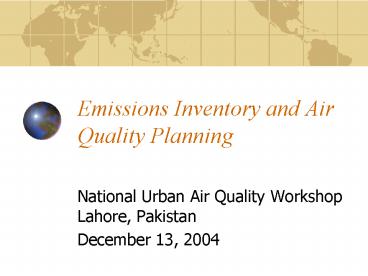Emissions Inventory and Air Quality Planning - PowerPoint PPT Presentation
1 / 24
Title:
Emissions Inventory and Air Quality Planning
Description:
Based on emissions inventory data, Baltimore has estimated NOX emissions of 475 tons per day ... government, industry, taxi/bus associations, police, ... – PowerPoint PPT presentation
Number of Views:116
Avg rating:3.0/5.0
Title: Emissions Inventory and Air Quality Planning
1
Emissions Inventory and Air Quality Planning
- National Urban Air Quality Workshop Lahore,
Pakistan - December 13, 2004
2
Topics of Discussion
- Air Quality Planning Matrix
- What is an emission inventory
- Why is emission inventory needed
- What is role of air monitoring and modeling
- How to develop control strategies
- Case Studies and Lessons Learned
3
Matrix for Air Quality Planning
- Adopt air quality standards
- Establish air monitoring network
- Develop emissions inventory
- Develop control strategies
- Test strategies through modeling
- Involve and educate public on strategies
- Adopt air quality management plan
4
What is an Emission Inventory?
- Complete listing, by source, of air pollutant
emissions - Covers a specific geographic area
- Covers a specific period of time
- Organized by type of data (e.g., point, area,
mobile, biogenic)
5
What can EmissionInventory tell you?
- Where air pollution is emitted
- How much is emitted from each source
- What sources would be most effective to control
6
What can Emission InventoryNOT tell you?
- The distance that air pollutant emissions are
transported - The amount of air pollution to which people are
exposed - The health risk fromthe air pollution
7
Why is emission inventory needed
- Identify sources of pollution
- Identify pollutants of concern
- Identify distribution and trends
- Input to air quality monitoring
- Input to air quality modeling
- Input to develop control strategies
8
How is Emission Inventory used?
- Identifying and planning for allocation of source
contributors - Developing an emissions control strategy
- Permitting sources and imposing emission fees
- Public information and awareness
- Monitoring and tracking of emissions trends
9
Sources of Emissions
- Stationary (e.g. industrial processes, fuel
combustion) - Mobile (e.g. on road and off road vehicles)
- Area wide (e.g. landfills, open burning)
- Biogenic (e.g. vegetation, soils)
10
Building an Emission Inventory
11
How to inventory emissions?
- Continuous emission monitors
- Periodic stack tests
- Emission Factors
- Material balance
12
Source Activity Data Required
- Vehicles - registration by mode, traffic
projections - Fuel Use vehicles, industry, home
- Industrial Production products, volume,
combustion, pollutants - Weather temperature, Rainfall
- Growth population, development, distribution
13
Forecasting future emissions
- Projected population growth
- Projected development growth
- Projected emissions growth
- Determine what and where emission sources will
require additional controls
14
Role of air quality monitoring
- Establish air quality monitoring network
- Determine key pollutants for which monitoring
will be done - Establish guidelines for sitting monitors, data
handling and reporting - Measures concentrations of key pollutants to
compare to air quality standards and develop
control strategies
15
Role of Air Quality Modeling
- Test control strategies based on modeling inputs
(emissions inventory data, meteorological data) - Validate against monitored air quality data
- Weigh evidence, take mid-course correction, and
make changes to strategies if necessary
16
Developing Control Strategies
- Determine key pollutants of concern from air
monitoring - Review contributions of pollutants from source
sectors using emission inventory - Evaluate control strategies based on technical
feasibility, cost effectiveness, affordability to
source, public acceptability, and adverse effects
on other environmental media
17
Enforcing Control Strategies
- Ensure legal authority to enforce through
statute, regulations, court - Incorporate strategies in permit conditions for
existing and new sources - Outreach to affected sectors, industry, and the
general public to promote compliance
18
Case Study State of Maryland, US
- Maryland has 15 air monitors showing exceedance
with National Ambient Air Quality Standards
(NAAQS) on average 14 days a year - USEPA has found Maryland to be in severe
nonattainment of NAAQS for Baltimore and
Washington areas
19
Maryland Case Study
- Based on emissions inventory data, Baltimore has
estimated NOX emissions of 475 tons per day - Major source emitters include
- Utilities (179 tons), light duty gasoline
vehicles (70 tons), heavy duty diesel vehicles
(55 tons), general manufacturing (38 tons), and
farm equipment (8 tons)
20
Maryland Case Study
- Enhanced inspection and maintenance program is
estimated to reduce 70 tons per day when fully
implemented - Strongly opposed by the general public based on
inconvenience to motorist - Major public awareness campaign launched by
government, industry and NGOs - Legislators voted to change mandatory program to
voluntary, Governor forced to veto legislation
during election year
21
Case Study Chiang Mai, Thailand
- Chiang Mai is the second largest municipality in
Thailand and had lacked capacity in air quality
management - Thai Pollution Control Department, Chiang Mai
Municipality, and State of Maryland worked
together to develop first air quality plan for
Chiang Mai
22
Chiang Mai Case Study
- Emissions inventory database was developed in
three source categories stationary, area, and
mobile - For stationary sources, questionnaire sent out to
industry based on activity (food agriculture,
waste disposal, wood products, storage tanks) - Information collected on type/amount of material
used, fuel, production capacity, operating
time/season, combustion units, control devices,
type of emissions
23
Chiang Mai Case Study
- Achieving Environmental Results Workshop held
with stakeholders government, industry,
taxi/bus associations, police, NGOs, religious
leaders, academia, media - Stakeholders brainstormed on menu of control
strategies - Based on stakeholder inputs, air quality
management plan adopted - Citizen Advisory Committee established to monitor
compliance
24
Lessons Learned
- Effective air quality planning requires a
reliable database for decision-making - Building database requires documentation,
computerization, training, and continuous efforts
- Choices of control strategies will vary based
sources, growth, feasibility, and acceptability - Public participation and awareness of urban air
quality issues is key to political will and
ultimate success































